Anapulse ANP100 Finger Pulse Oximeter With LED Display
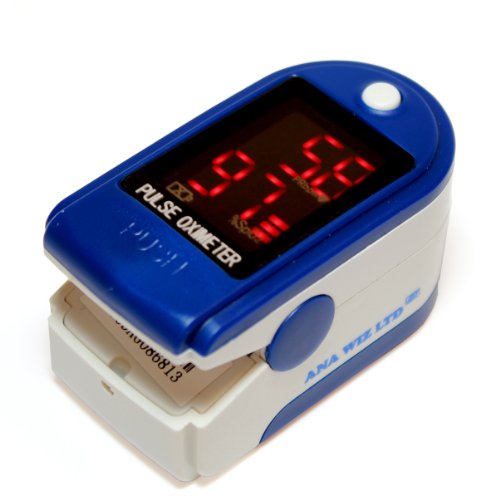
Anapulse ANP100 Finger Pulse Oximeter With LED Display (Includes Carrycase, Batteries and Lanyard)

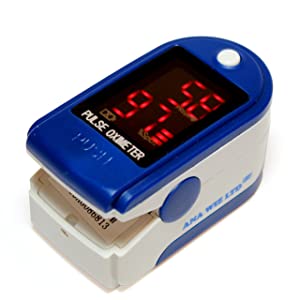
ANP100 Finger Pulse Oximeter
Includes Carrycase, Batteries and Lanyard
The ANP100 Finger Pulse Oximeter is the perfect choice for on-the-spot SpO2 and Pulse Rate testing. The unit’s lightweight and small size means it can be easily carried in your pocket. The pulse oximeter automatically switches off when a finger is removed from the unit for more than 5 seconds. The LED Display can be seen even in low ambient light levels.
Suitable for a wide range of users
The universal finger clip allows the oximeter to fit a range of finger sizes from paediatric (from approximately 5 years) through to adult.
Ideal for GP’s, Paramedics, Nurses, Community Workers as well as home users that need to monitor their oxygen levels regularly. In addition to sportsmen or women that would like to monitor their saturation levels and heart rate.
Technical Specification
- SpO2 Range: 35 – 99 %
- SpO2 Accuracy: ± 2%
- Pulse Range: 30-250 bpm
- Pulse Accuracy: ± 2 bpm
- Weight: 50g
Key features:
- Accurate SP02 (oxygen saturation) and heart rate measurement
- Suitable for GP’s, Paramedics, Nurses, Community Workers as well as home users
- Small lightweight unit complete with carrying case and lanyard
- Frequently used by people with respiratory illnesses such as asthma and COPD
- EN ISO 13485:2003 compliant Conforms to UK and EC Medical Safety Requirements CE 0123
- Supplied to the NHS across the UK.
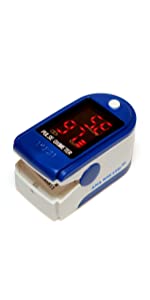 | 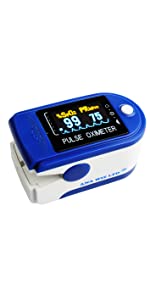 | 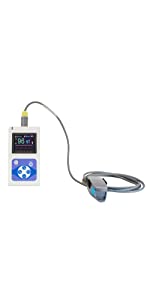 | 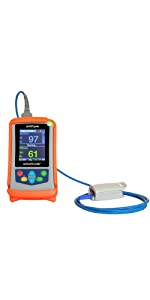 | |
|---|---|---|---|---|
| Suitable for on-the-spot SpO2 | ✓ | ✓ | ✓ | ✓ |
| Suitable for continuous monitoring over a period | ✓ | ✓ | ||
| Warranty period | 1 year | 1 year | 1 year | 2 years |
| Replaceable sensor | ✓ | ✓ | ||
| Adjustable alarms | ✓ | ✓ |
| Brand: | Anapulse |
| Origin: | China |
I have incurable cancer and the hospital and oncologist require me to take regular readings of my pulse and blood oxygen. This is, among other readings to control my medicatio
As an Asthematic I like to keep a check on my vital signs. This is an easy-to-use Oxygen monitor.
It is accurate, checked against a Hospital monitor.
If you need to see your O2 levels this is a fairly cheap and easy to use device.
Make sure your hands are warm to the touch as the reading might not be accurate, also nail varnish and gel nails affect the reading.
In summary, easy to use, reasonably priced, well made and an excellent tool to monitor your health.
I had seen these mentioned when covid was rampant as people often didn’t realise how low their oxygen levels were dropping. I then saw one used on a friend and decided to buy it – I am mildly asthmatic. I don’t know exactly how accurate they are but it is very good for tracking your oxygen rates as a comparison with previous readings. I sometime see that my oxygen levels drop to low 90s and it can be an indicator that I need to use my inhaler (or I need to breathe better!). The numbers are easy to read and it also gives your pulse reading.
A few weeks ago I bought the Metene Oximeter which turned out to be utter rubbish (see my review).
This is my second purchase of the Anapulse 100 and it is a vastly superior product. Accuracy, reliabiility, and build quality is good.
Just wish I’d have bought this again instead of trying the Metene one, which, incidentally, was more expensive.
I might add that my Doctor recommended the Anapulse 100 anyway – he uses it in his surgery.
This pulse oximeter works well once you get used to it. Takes some time to show the reading. Initially i thought it was not working properly. Just give it 20 secs or so and the reading will come
Purchased to use when exercising outdoors but unfortunately if your hands are cold it does not give accurate readings( says this in the manual). Apart from that, everything else about it is good.
My dad has been struggling with his breathing lately this has given him some peace of mind. It also help him to not provide the GP with better information when he calls up to explain how he has been feeling.
At first inspection there was no protective film on the display, upon closer inspection the display shows signs of scratching and light abrasion this suggests quality control of product during handling requires improvement.
Initially customer suspects that this product is not new but used.
Other than the above observation the device appears to operate according to expectations.
It was super-easy to set up with the (supplied) batteries. Obviously, I immediately tested it on my middle finger (been in hospital a few times so I knew the drill – and it was dead easy to use) and it gave me two figures: my blood oxygen level was 96 (anything above 95 is OK); can’t remember my heart rate but it sounded normal…
I can’t comment on the accuracy (as – of course – I have not done any comparative testing) but I gave 4* for accuracy as it felt to me like it was giving good results. IMO, this is a good bit of kit to have in your bag if you are a first-aider – lightweight, not that expensive…
Also very useful if you ever think you may need to report a patient’s condition (e.g. a relative) to emergency services.
It reads about one tenth of a degree lower than another I have, but most of these products have a plus or minus one or two tenths written into the calibration, it is norted on the paperwork supplied.
If this is vital for you, check the reading against one in the surgery when you are there next. Or compare it, under same conditions, to one you are happy with.
Always dry and warm your fingers before use.
Try and check your oxygen on a fairly regular basis, when seated and rested, until your are sure if your ‘ baseline’ for comparison later.
Give the reading a minute to settle.
Make a note of the results, just as you would building up a blood pressure record: then you know what to expect and will be able to tell if it is good or worsening if you are unwell.
If you can afford it, get two for comparison.
Always have spare batteries as the reading can be affected by a failing battery, but they should last a while.
A word about avoiding Covid.
Wear a mask in crowded places if you are vulnerable, to spare your lungs: don’t be afraid to do so if others are not- only you know your own body. A good quality FFP2 or3 mask will give you extra protection, usually, than a cloth mask- if you use those wash and thoroughly dry them every day.
If you are unsure of your source, buy from a Uk chemist, you can still shop online.
I would avoid anything sold outside of Europe or the UK as it is not really possible to be sure of the grading – which is different elsewhere in any case.
The mask should fit snugly with little or no air gaps around it. Make sure it is safely attached to your head – many medical masks have ties instead of ear loops, or the loops go around the head for security. Replace the mask when it gets damp. Do not wear disposables for more than a few hours.
You can use a disposable ‘paper’ mask, like the blue ones nursing staff and vaccine staff wear-again, be aware these are not ‘sealed’ so aerosol can get in there, but they give fairly good protection. Buy them sealed, in boxes from a trusted European medical company to be sure your kite mark is reliable.
I bought this oximeter back in August after the first lockdown, but I did notice this fluctuated in price a lot. I managed to get it for 17 when it had settled down, but I saw it go up to something like 30 or so. I don’t really approve of them taking advantage of these unfortunate times, but I guess that’s the life of supply and demand.
What’s in the box:
-Oximeter
-x2 AAA batteries
-Lanyard
-Rubber coving
-A case
-Instructions
It’s really easy to use – press the white button, attach it to your finger and wait a few seconds. It will read your oxygen level (SpO2) and pulse rate clearly on the red display. Very rarely, but sometimes it can misread the levels, for example wearing nail varnish can affect this, so just try again. After 5 seconds of removing your finger, it automatically turns off, so you don’t need to press or hold down the button when finished. It’s really lightweight and can fit in your pocket, or around your neck with the lanyard.
This oximeter is great to have in general, but good for anyone who may be paranoid/anxious about coronavirus symptoms (e.g. shortness of breath), or, if you are caring for someone. It does state that this is supplied to the NHS across the UK and I think it’s a good piece of equipment to have in your medical box.
We also have the ONYX pulse oximeter so I put these on side by side and the readings were the same. The ONYX retails at around 125 and does the exact same thing this one does which was only 20. In the photo you will see the displays of both the ANAPULSE 100 and the ONYX.